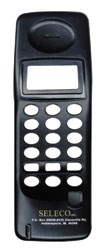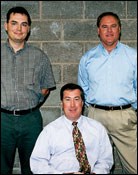Selectively Plating Plastics the Seleco Way
How tough can it be to put in a plating line and start running a job shop? Faced with the idea that it was no longer going to be simply a supplier, but the actual plating job shop, Seleco Inc., prepared itself. However, the learning curve was steeper than it planned...
Share
We didn't expect to be running a plating shop," stated Blair Vandivier, president of Seleco, Inc. (Indianapolis, IN). "We thought we would develop this technology, license it out and wait for the royalty checks to come in." But, it didn't work out that way. Mr. Vandivier, who is also president of Benchmark Products (Indianapolis, IN), thought that as a chemical supplier, the hard part was developing and manufacturing the chemistry; the easy part was running a plating shop.
The story began with an idea for selectively plating plastics without etching. This may be important if the as-molded color and appearance of the plastic parts need to be maintained or if selective plating is called for. The traditional method for selectively plating plastics was to put a resist coating on the portion of the part you did not want plated. Then you would plate the entire part and peel off the resist coating, generating a lot of waste in addition to the labor and expense of applying and removing the resist coating.
The Seleco method developed by Benchmark uses a latex-based coating, which eliminates the need for an etch step. The reason the idea even came into existence in the early 1980s was due to FCC regulations that required limitations on the EMI emissions of certain electronic devices. "There were stories of people who could not use their televisions and home computers at the same time because of magnetic field interference. The existing technologies did not provide adequate shielding effectiveness," noted Mr. Vandivier. "So we put this technology together and patented it."
The company's first customer was a Midwest automotive electronics supplier. Benchmark knew that the customer had a plastics plating line at one of its facilities. It assumed that the customer would simply add a few plating tanks for the new process. But, the situation short-circuited. The customer did not want to be in the plating business and was not interested in expanding its plating shop. In fact, it wanted Seleco to do the plating.
However, all Seleco had was a little prototype line, which it had set up to run a few parts at a time. Rather than lose its first and needless to say largest customer, Seleco became a job shop plating company. Now, Seleco serves many Fortune 500 companies in industries needing EMI/RFI shielding, including telecommunications, medical, hand-held RF devices, automotive and electronic test equipment.
Streamlined Shielding
Originally Seleco shared its facility with a construction company. However, business really took off in 1988 after Seleco acquired more customers, and the construction company left to find new headquarters.
"We went through an excruciating learning curve," noted Mr. Vandivier. "We found out a lot of things we didn't know about scheduling jobs and quality systems. You name it; we learned it-the hard way."
Even though different customers have different applications for the same plating process, the plating is the easy part according to Rich Lewis, operations manager. "Managing different constraints of the shop is the hardest part of the job," commented Mr. Lewis. The company has invested in an ERP (Enterprise Resource Planning) system that integrates the company's financial, purchasing, tracking and basically all information on a part. "It helps a lot with scheduling since we have added complexity to our operations, such as some assembly, ultrasonic welding, insertions and pad printing," noted Mr. Lewis. Seleco wanted to offer these operations in addition to the superior shielding the process provides; it gives its customers a competitive advantage in the marketplace.
Another operational change that has helped Seleco is streamlining. "We used to run everything in large batches. We would end up painting a thousand parts at a time. We would have parts stacked up waiting for plating. Now we run continuous smaller lots. Our processing times have been reduced from days to hours. By being more nimble, we are able to be much more responsive to our customers' needs," said Mr. Lewis.
Producing in small, continuous batches has also saved the customers money, since the customers purchase the plating racks. Rack needs at Seleco have been cut by one-third. The continuous cycling means less fixturing is needed. The company has also developed a special proprietary rack coating that allows the racks to run longer cycles without the need for stripping and recoating.
Seleco has also streamlined its drying process so that the entire finishing operation is more efficient. It used to have drying rooms where parts would sit for a day or overnight to dry. Now painted parts go through an infrared oven where they are dried in 5-15 min. Plated parts are dried in about the same amount of time using a forced air oven.
The Seleco Process
As Mr. Lewis said, the plating is the easy part. However, Mr. Vandivier pointed out that it is still a unique process, and the best choice of conductive coatings for EMI shielding. So what is the Seleco process?
It is a unique solution to EMI/RFI shielding and ESD problems. It is an environmentally friendly process that does not require any chemical etching or pretreatment of the molded plastic part. The process provides a selectively applied, uniform, thin layer of metal where required by individual part design that results in a high level of shielding effectiveness.
The process is based on an autocatalytic chemical plating process that produces a pure, continuous and uniform coating of copper and nickel to achieve EMI shielding. The electroless nickel topcoat protects the electroless copper sublayer from oxidizing and corroding. The nickel layer also provides abrasion and wear resistance.
Prior to plating, a waterborne latex basecoat containing virtually no VOCs is applied to the area of the part to be plated using conventional spray-painting techniques. The basecoat establishes selectivity and maintains adhesion to the substrate. It also provides for minimal stress on the molded part compared to solvent basecoats or chemical etching processes. Plating thickness is not dependent on the basecoat's thickness, and the basecoat can reach all areas of complex molded parts. Plating then takes place on all areas where the coating has been applied.
The shielding effectiveness of the part is dependent on the highly conductive electroless copper-shielding layer, which is approximately 75-150 microinches. Electroless copper is used because in addition to the electroless process, which provides uniform thickness, it is the second most conductive metal (only to silver) and as such is excellent in its shielding effectiveness. It also has resistance readings between 50 milliohms and 1.0 ohm, depending on the customer specifications.
Conductive paints have been used in certain situations in place of electroless copper plating for EMI shielding. For this technology, conductive filler and pigments are incorporated into a resin binder. The most common fillers are copper, silver, graphite or nickel. These processes, however, usually involve high-solids, solvent-borne processes, and typical overspray losses are 30-40%. Their shielding performance also varies with the thickness of the dry paint film and the conductivity of the paint, and surface resistivity also is affected. If the paint is flooded onto the part, the conductive fillers may settle into the paint film and reduce conductivity. Also, as Mr. Vandivier points out, the paint can chip or flake and wipeout an entire circuit board.
Vacuum metallizing can also be used, however, this is a line-of-sight technology, making masking and fixturing more important to its success as design complexity increases.
Following copper plating at Seleco, the copper is activated using a palladium solution. This prepares the surface for electroless nickel plating.
Because copper will oxidize when exposed to the environment, approximately 25 microinches of electroless nickel is applied to the parts. The electroless nickel also protects the copper from corrosion. If a thicker coating is required, the parts are simply immersed in the solution longer. In some cases, thicker coatings are desired to accommodate certain attachment procedures, such as soldering or to further enhance corrosion and wear performance.
Control and Waste Treatment
Startup and shutdown of the electroless nickel on Seleco's plating line is rather different from most electroless nickel plating systems. Rather than control the plating line with chemistry, Seleco uses a chiller and double boiler system. At night the tanks are cooled from 115-130F to 50-75F in a couple of hours using chilled water. The system is automatically set up so that in the morning the boilers come on and heat the solutions to temperature. Also, rather than use turnovers as a means to determine when to dump the electroless nickel bath, the company measures the orthophosphite in the bath.
For waste treatment Seleco uses cartridge filtration on the baths and ion exchange to remove nickel and copper. "As a general rule, we are not a hazardous waste generator," noted Mr. Lewis. "Our entire operation has been developed on the principle of environmental friendliness. All of our processes are clean, which is as important to us as it is to our customers. In a way, the shielding we provide keeps their products clean as well."
There are many differences between running a supply business and a job shop, as Mr. Vandivier has found out. "With a job shop, you are consistently making investments in capital equipment that you may or may not see a return on. If you don't make the investment, you cannot be competitive on the job, but there is no guarantee that the job is going to come. Capacity and customer demand are the biggest issues. You have to be very nimble on your feet. On the supply side your investment is in technology and people, which is much different from the job shop side."
To learn more visit Asterion and Enthone Inc..
Read Next
Delivering Increased Benefits to Greenhouse Films
Baystar's Borstar technology is helping customers deliver better, more reliable production methods to greenhouse agriculture.
Read MoreReducing Material Use and Overspray
Looking for applicators or process improvements for reducing material use and overspray? Binks offers helpful advice for searching out new solutions.
Read MoreThe Best Tape for High-Temperature Applications
High-temperature tapes are designed with maximum heat ratings indicating the highest temperature they can withstand for a very short time.
Read More


























